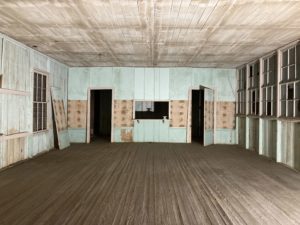Montopolis school for Black students reopened its doors as neighborhood fights for preservation
Thursday, November 11, 2021 by
Willow Higgins Montopolis Negro School, a segregation-era grade school for Black children, reopened its doors on Saturday, welcoming Montopolis residents new and old, including some former students, back to an alma mater that hasn’t operated as a school in 60 years.
The Parks and Recreation Department hosted the open house to give community members an opportunity to envision how the space might be used in the future. The nearly 2-acre plot of land has had a contentious history, but the community has fought for years to preserve the history of the school and save it from demolition and development. On Saturday, neighborhood advocates, many of whom grew up in Montopolis, championed the idea of using the tract as a community center and museum that could serve as a tourist attraction and resource hub for community members, as well as an educational tool to remember the history of the segregated South.
“The people who come to Austin now need to know who paved the way before them,” said Fred L. McGhee, a community advocate and author of Austin’s Montopolis Neighborhood, a book that recaps the history of the area. McGhee, who has been involved in the negotiations and hopes to help run the former Montopolis Negro School if it were to become a community center, imagined connecting the school to a walkable and bikeable trail to the Montopolis Bridge.
“This building sits in a cultural landscape,” he said.

The Montopolis area, which was historically used for cotton cultivation, was its own city before Austin was even colonized. Austin eventually annexed Montopolis as a neighborhood in the city’s southeast. But now, as Austin’s real estate market has boomed, the area faces gentrification. At the open house, neighbors avidly discussed what’s happening to so-and-so’s property and how much it sold for, mentioning a select few developers like household names.
Since the 1950s, Montopolis Negro School’s property has been traded between churches, Travis County and the city’s school district. When AISD shuttered the school in 1962 in order to open Allison Elementary, a racially integrated public school, the building became the Montopolis Church of Christ and functioned as a place of worship until the 1980s. When the church closed its doors, the building remained vacant until 2015, when a private developer purchased the land, intending to develop homes, stores and offices. But community advocacy and a fight to designate the tract as a historic landmark stopped the building from being demolished, and the city eventually reclaimed the property by eminent domain.
Years later, the fate of the land remains uncertain, but those biting their nails should have an answer by spring 2022, when City Council considers the items of the Austin Strategic Mobility Plan. The Transportation Department has a stake in the deal, as there are proposed plans to build a roadway adjacent to the site. But the ASMP could block plans to develop the road, which advocates argue would intrude on the historic tract, and pass responsibility for the land to the parks department. Montopolis community members want to partner with PARD to transform the school into a community center and operate it as a historic community asset.
Carol Mae Williams, a Montopolis local whose family name is Atwood – just like Montopolis’ Atwood Street – went to Allison Elementary, but her mother and older siblings attended Montopolis Negro School. Due to health concerns, her mother didn’t attend the event, but still lives in the neighborhood and is rooting for the school’s preservation. “This (land) is family,” Williams said, looking around. “This is a piece of my mother.”
The Austin Monitor’s work is made possible by donations from the community. Though our reporting covers donors from time to time, we are careful to keep business and editorial efforts separate while maintaining transparency. A complete list of donors is available here, and our code of ethics is explained here.
You're a community leader
And we’re honored you look to us for serious, in-depth news. You know a strong community needs local and dedicated watchdog reporting. We’re here for you and that won’t change. Now will you take the powerful next step and support our nonprofit news organization?












